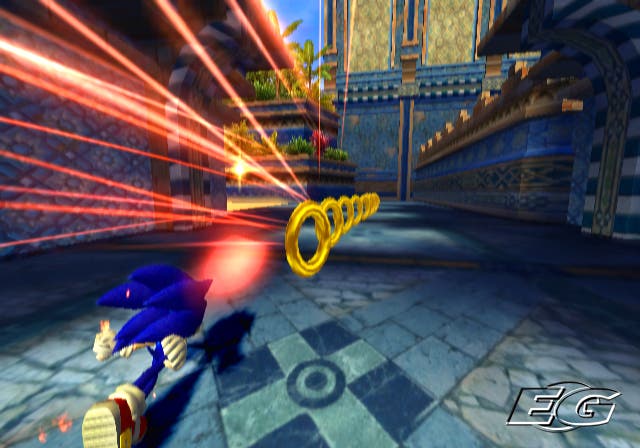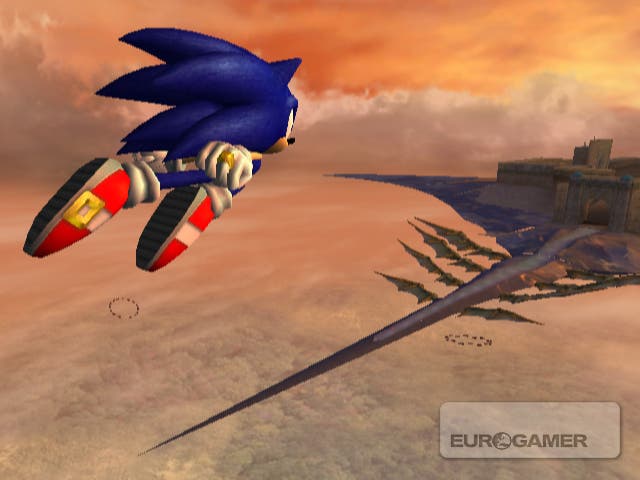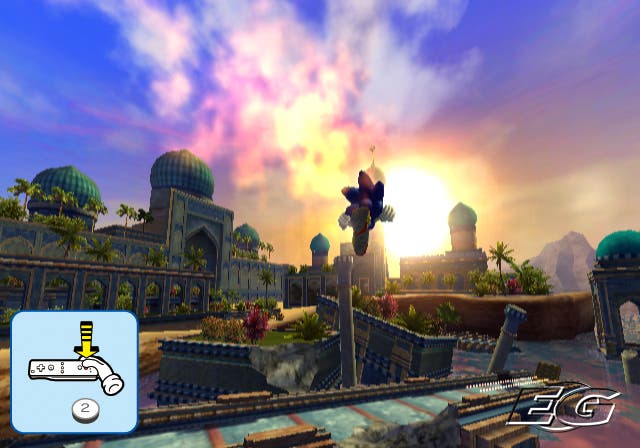Sonic and the Secret Rings
All hail the comeback kid.
Like many people, I've got a friend who has a bit of a Michael Jackson thing going on. Not a crazy "We Love You Michael" type, before you start rolling your eyes. Just a relatively rational fan, who liked him back when the singing and the dancing were so good that we were all prepared to ignore the lightened skin and bizarre media reports. So, to her, it's still pretty exciting every time it looks like Jackson is going to hop back out on stage and do some of the dancing and singing again. Every time, she tells me, there's a whirlwind of speculation in Jackson fandom. This time, he's putting a decade of nasal necrosis, babies dangling out hotel windows, extraordinary court cases and flirtations with bankruptcy behind him for once and for all. He'll sing and dance again, and there might even be new material. It'll be back to the good old days.
Every time, of course, she's bitterly disappointed. With every public appearance he seems more like whispering, broken shade of the man who so eloquently denied fathering Billie-Jean's child - and yet somehow, she always falls for the hyperbole again a few months later. Okay, so it didn't happen last time, but how about this time? Could this be the one?
Is she mental? Undeniably. Absolutely raving loco. However, as gamers, we should be able to sympathise, because it's not like we don't have our own icons, our own star figures of yesteryear who are trading off memories and haven't done anything half decent in years. Case in point; Sonic the Hedgehog. Once, he stood toe to toe with Mario, and he was leaping around the Green Hill Zone before the majority of modern icons were twinkles in the eyes of their creators. In recent years, though, every home console Sonic title has been worse than the previous game - with only the solid PSP title, and the actually rather good DS title, to rescue the quality of the franchise in any way.
And yet... we can't let go. Every time a new Sonic appears on the horizon, we fervently hope that this will be The One. This will end the downward spiral. It will bring back the Good Old Days, when Sonic was a blur of speed with a cheeky grin attached, before the bad times. Sonic may be drunk, unshaven, surrounded by Johnny-come-lately sycophants like Shadow and Big The Cat who were attracted only by his wealth and fame, and snorting crushed-up golden rings from the breasts of cheap hookers - but he was great once, and somewhere we all believe that he'll be great again.
We believe this, and every single time, we're utterly disappointed. Every single time, after playing the latest excerable muck, we claim to be totally over Sonic. We get more and more cynical, more and more derisive... But with child-like innocence, we bounce back, and secretly click on the screenshots of the next Sonic game. Maybe this time...
Are we mental? Undeniably. But sometimes it pays to keep the faith. The wait is over. Sonic is back.
Blue Flash

Sonic and the Secret Rings may be the worst name for a Sonic game in quite some time, but it doesn't matter - it's by far the best game the blue spiny one has starred in for years. Not only that, it's the first 3D Sonic game which genuinely works; a game which strips down the model created in Sonic Adventure to the core elements which made it fun, disposes of the dross which wasn't fun, and constructs a genuinely great experience from it.
The premise of this Sonic is a bit of a departure from previous games in the series. Sonic is called upon by a genie named Shahara, who inhabits the world of the famous book Arabian Nights, and is informed that an evil Djinn is attempting to absorb the power of the book. Sonic is then pulled into the world of the book, and the game takes places across a variety of worlds ("chapters") which are contained within its pages. While these worlds do conform to game stereotypes to some extent, and each one is themed differently, they all conform to some extent to the central art style and theme of the game. This makes it altogether more cohesive than previous Sonic titles.
The storyline is bound together using hand-painted cutscenes, which is another artistic departure from Sonic's recent outings. Although the paintings are animated to some extent, the effect which the designers are aiming for is paint on parchment, and the resulting visuals are striking and interesting - vastly more so than the bog-standard rendered movies we're used to in Sonic games. The cutscenes are all fully voiced, which unfortunately exposes you to the horror of having to listen to some of the most utterly awful voice acting we've ever heard. Thankfully, you can select Japanese with subtitles, which may be less comprehensible but is much easier on the ear.
In gameplay terms, the premise of the game has one absolutely crucial effect - since Sonic has been dragged into the world of Arabian Nights alone, this game is about Sonic. You play as Sonic - not as Knuckles, not as Tails, not as Amy, not as Shadow, and not as any of the other misfits who seem to occupy most of the screen time in recent Sonic Adventure style titles. This is a Sonic game; you play Sonic. You go very fast and you jump on things. That's what Sonic does, and the dawning realisation that that's exactly what this game planned to focus on for its entire duration made the first vestiges of a smile touch the corners of our mouths.

That smile widened to a broad grin when we discovered that not only do you play as Sonic throughout the game, but that playing as Sonic is awesome. The game is, in effect, a series of vast, sprawling levels, through which you move partially on rails. Left to his own devices, Sonic automatically accelerates and takes the right direction through the level; your job is to jump obstacles, steer left and right (within the confines of the rails) to pick up rings and pearls, deal with enemies and hop between platforms, rails and other such handy bits of scenery. There's a brake, but no forward or accelerate button; acceleration is Sonic's default state. Assuming you don't screw up and run him into an obstacle, he'll start out at jogging pace and rapidly get up to breakneck speed.
Tilted Generation
The controls for the game make excellent use of the Wiimote. In this instance, you hold the remote horizontally, with your left thumb on the D-pad (although this is only used for menu selection) and your right thumb over the 1 and 2 buttons. To steer, you tilt from side to side, and this is a motion which becomes incredibly natural after only a few minutes with the game, and allows for very precise adjustment to pick up tricky lines of rings. To brake, you press 1; to walk backwards (which you'll rarely need to do), you tilt the Wiimote back towards yourself. To jump, you press 2 - a short tap for a quick leap, while holding it down will charge up a more powerful jump. In either case, thrusting the controller forward while jumping will send Sonic hurtling forward through the air, or, if an enemy is nearby, will perform a mid-air homing attack on that enemy.
It's a simple and intuitive system, but what's more important is that Sonic and the Secret Rings plays to the strengths of its control system rather than exposing its weaknesses. This system would, frankly, be completely crap for a game with a lot of combat in it, so Secret Rings places enemies sparsely, and generally uses them as platforms which you use to access new parts of the level rather than as obstacles. Equally, the tilt system is great for moving within a preset lane, but wouldn't be so hot for taking tight corners. So, to compensate, all of the tight corners in the game are actually built into the on-rails system, and Sonic moves around them automatically.

The result of these decisions, and of a general attention to detail in the level design of the game, is that you spend most of your time running through at stunning speed. As anyone who wrung enjoyment out of the Sonic Adventure titles can attest, it's those moments which provided the real adrenaline rush. Secret Rings essentially takes those brilliant, high-octane moments and makes a full-size game out of them, with a selection of superbly designed levels to race through and a variety of missions, objectives and goals on each level to provide different types of challenge.
In a sense, this is a black mark on Secret Rings' copybook - the selection of actual levels is small, with the game choosing instead to offer a variety of missions on each level. However, while it's initially a little bit disconcerting to be dumped back onto the level you just thought you'd finished, it quickly becomes apparent that this system is actually preferable in many ways to the throwaway levels of the Sonic Adventure games. Secret Rings encourages players to master its levels, treating each one like a track in a racing game rather than a conventional single-player level to be blasted through and forgotten.
Your first meeting with each level will be a run through the entire stage; after that, several missions on that stage are opened up. The objectives in these missions can be mind-bogglingly tricky in places, but often simply require a few attempts to get the hang of what exactly is required. By the time you've done a couple of missions, there's a very satisfying feeling of having really got to grips with even the tricky parts of the level - although getting better rankings and completing the tougher missions may still be a long way off. The downside is that on your first few run-throughs, some of the more tricky levels expect you to progress through trial and error. And while forgiving placement of checkpoints generally means that you won't end up with Wiimote-hurling frustration levels, it's still rather weak for a game in this day and age to be asking players to learn through trial and error because of avoidable blind spots and annoying leaps of faith.
Third Wheel

The core single-player game in Secret Rings isn't huge, but despite the relatively limited amount of content, there are a fair few hours to it. There''s probably a solid weekend's enjoyment for a decent player, with plenty left to do in terms of earning better rankings if the game has really hooked you at that point. The tight focus on a set amount of content has also allowed the team to craft one of the best-looking games on the Wii - and this is arguably the first title to actually show that the system has potential greater than its predecessor, the GameCube.
Secret Rings is by no means on a level with Xbox 360 or PS3 titles, but it's certainly comparable with the absolute best that the last generation had on offer. A combination of solid graphics and great artwork make for a title which is visually more appealing than the more technologically advanced, but ultimately drab and soulless, Sonic the Hedgehog title on next-gen consoles. Best of all, the framerate is consistent and excellent, and we didn't notice a single glitch or stutter even in the incredibly fast and heavily populated areas of the game.
The audio is a bit more problematic, sadly. And while we've already mentioned the dreadful voice acting (solved by switching languages), the music is equally awful. In places, there's fantastic incidental music which properly evokes the Arabian Nights theme which the game uses for its artwork, but the remainder of the music is shockingly bad teenagers-in-a-garage rock.
It doesn't even have the irony or the tongue-in-cheek tweeness of the rock tracks in Sonic Adventure; it's like someone just found half a dozen wannabe Fred Durst types on MySpace and stuck them on the soundtrack for the hell of it. We don't know who, exactly, decided that Sonic's tastes in music were going to run to dull American rock for teenagers who don't want to tidy their bedrooms (and are too young to appreciate good stuff to refuse to tidy their bedrooms to), but we suspect that he may be just a touch tone deaf.

The final aspect of the presentation is the addition of a completely spurious four-player mode, which consists of a number of Wiimote mini-games which are totally unrelated to the single-player game, and whose quality varies wildly. Well, not that wildly - it varies between "awful" and "decent", with not a "good" or a "great" in sight. To be honest, we have no idea why these party-games have been added, except perhaps to pad out the feature-list on the back of the box. Any Wii player who owns Wii Play, Wario Ware or even the somewhat derided Monkey Ball Banana Blitz already has a much, much better selection of mini-games available to them. We simply can't think of any situation where you'd pop Secret Rings into the Wii for some party-game action in preference to any of those titles. A multiplayer race or challenge mode set in the context of the main game would have been good. These lame mini-games merely serve to cheapen the whole package, and drag down a game which is excellent in many other ways.
Sonic Boom
There's a lot to be happy about in Sonic and the Secret Rings. It's a stripped-down and extremely polished game which successfully captures the essence of what made Sonic fun and exciting in the first place. Moreover, it reverses the horrible trend which Sonic Adventure (and latterly Sonic the Hedgehog) titles had followed, namely adding more characters and more pointless gameplay styles in the hope that if enough mud was thrown at the wall, some of it would stick. Secret Rings' developers understand that very often, less is more; this game has less characters, less variety of gameplay, less buttons on its control layout and less superflous features, and it's a far, far better game for it.
Sonic and the Secret Rings is a very bold step in the right direction, and we're delighted to see it happen. It's not perfect by any means; it still carries through some of the flaws that have afflicted Sonic for years, such as leap-of-faith jumps and sections which can only be completed by learning the track through trial and error. The presentation also needs work in some areas, and the multiplayer mini-games are frankly crap. However, this is a game about Going Fast and Jumping, and, at last, its designers have realised that that's exactly what we want to do with Sonic. The Going Fast is brilliant, the Jumping is fantastic, and we have big smiles on our faces. Sonic is back.








